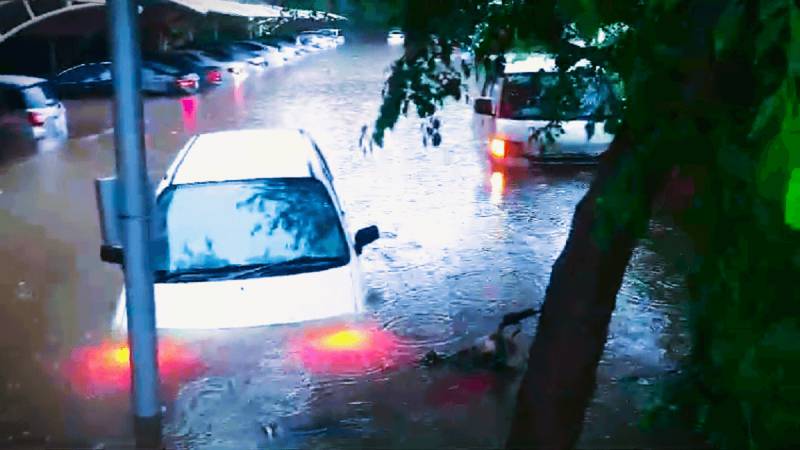
The monsoon season in Pakistan, particularly in cities like Lahore, Rawalpindi, and other parts of the country, has, in recent years, become synonymous with destruction and disruption. Every year, the arrival of heavy monsoon rains brings with it a sense of dread as residents brace for flooding, infrastructure collapse, and the subsequent loss of lives and property. Despite the predictability of these events and the significant advancements in meteorological sciences, Pakistan remains woefully unprepared to effectively manage and mitigate the impacts of these natural calamities.
Every year, lives are lost, families are displaced, and livelihoods are destroyed in the heart-wrenching human toll of these disasters. Consider the hard work, resilience and personal sacrifices that the people make to build their houses and businesses. To then watch images of submerged homes, overturned buses, and people wading through waist-deep water, starkly reminding us of the failure to address the root causes of the problem. These losses can cast a shadow over one's soul, akin to an apocalyptic despair which engulfs all hope not just as a consequence of natural forces but also as a reflection of systemic neglect and poor governance.
A key factor contributing to the insufficient response to monsoon-related disasters in Pakistan is the absence of thorough planning and coordination among the concerned authorities. Although the Pakistan Meteorological Department (PMD) issues timely forecasts and warnings, these often do not lead to effective action plans at the community level. This gap between forecasting and actual preparedness is evident, rendering cities such as Lahore and Rawalpindi susceptible to the severe impacts of intense rainfall. The piecemeal disaster management strategy, marked by a lack of collaboration between different government and non-government entities, fosters a reactive rather than a proactive approach to the challenges posed by the monsoon season.
Furthermore, the lack of a clear and effective sewerage system worsens the situation. In cities such as Lahore and Rawalpindi, the urban infrastructure struggles to cope with the heavy monsoon rains. The drainage systems, frequently blocked with debris and poorly maintained, are unable to effectively divert rainwater from residential and commercial zones. Consequently, this results in extensive flooding, submerging homes, businesses, and thoroughfares. The absence of investment in modernising and enlarging these drainage systems exacerbates the issue, leaving the cities vulnerable to the annual onslaught of the monsoon.
Furthermore, rapid urbanisation and population growth in cities such as Lahore and Rawalpindi present significant challenges. The swelling population exerts tremendous pressure on its civic infrastructure, which struggles against its everyday needs, much less handle the severe conditions of the monsoon season. The disorderly expansion of urban areas encroaches upon natural drainage channels and water bodies, aggravating risks of flooding. Therefore, addressing the challenges of urban planning and sustainable development is crucial to lessen the impact of future monsoon seasons.
Even with the regularity of monsoon-induced disasters, there remains a persistent shortfall in investments for disaster readiness and infrastructure enhancement
A significant factor in the recurring monsoon crises is the inadequate emphasis on adopting preventive measures. Even with the predictable nature of the monsoon season, there is an apparent shortage of efforts to lessen its effects. For example, while early warning systems exist, they are not efficiently relayed to the populace. There is an urgent need for comprehensive public awareness campaigns to inform citizens about the potential dangers and protective actions for their and their property's safety. Additionally, weak enforcement of zoning regulations and building standards that consider the flood susceptibility of certain regions leads to unregulated construction in flood-prone areas, intensifying the damage during heavy rainfall.
In addition to the immediate physical damage, the long-term socio-economic impacts of monsoon-related disasters cannot be overlooked. Flooding disrupts daily life, halts economic activities, and strains public resources. Schools are closed, healthcare services are overwhelmed, and transportation networks are paralysed. The economic losses run into billions, with businesses suffering from downtime and damage to infrastructure. The poorest and most vulnerable communities bear the brunt of these calamities, often losing everything and struggling to rebuild their lives with limited support.
This raises the question: why are we unprepared or fail to plan for these events and mitigate losses from these foreseeable calamities? A portion of the answer resides in the absence of political determination and the low priority given to disaster management. Even with the regularity of monsoon-induced disasters, there remains a persistent shortfall in investments for disaster readiness and infrastructure enhancement. The distribution of resources often favours more conspicuous and politically beneficial projects, overshadowing the vital yet understated endeavour of fortifying resilience to natural disasters.
Moreover, corruption and bureaucratic inefficiency impede the effectiveness of disaster management. Allocated funds for infrastructure development and maintenance frequently suffer misappropriation, leading to inferior projects that cannot endure the challenges of the monsoon season. The absence of transparency and accountability in public fund utilisation weakens the establishment of a stronger disaster management framework at the expense of the vulnerable and tax-paying population.
The impact of climate change on intensifying monsoon-related disasters is undeniable. Shifts in weather patterns and a rise in the intensity of rainfall events are expected to aggravate these challenges in the coming years. This complexity compounds the already demanding job of disaster management. It highlights the necessity for an inclusive and proactive strategy that incorporates climate resilience into the fabric of urban planning and infrastructure development. The authorities must initiate collaborative actions involving governmental bodies, NGOs, businesses and common citizens to build a resilient, disaster-prepared Pakistan.

